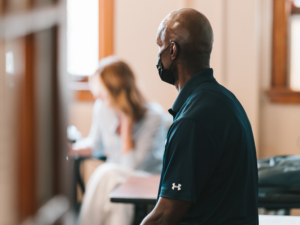What Teachers Really Want

Responding to a standard email request for permission to use a digital tool in my classroom, a parent of one of my students recently gave me carte blanche to help her child learn. I almost got up from my desk and danced a jig. Not only did I feel truly appreciated for the work I have done this year to empower my students as self-directed, curious learners, but I also felt a much needed affirmation of trust in my ability to make professional choices in the classroom, even as we might play around, attempt the unknown, fail, and start over. Thank you, thank you, I thought, for the parents who understand what real learning is and who trust me to teach the best way I can.
Yet these are dark days for teacher appreciation for many in our profession. I felt a definite low point at the beginning of April, when I encountered within 48 hours, two popular media sources at opposite ends of the political spectrum (Fox News and The Huffington Post) that openly ridiculed teachers for mistakes they had made. Bashed by the media, harassed by parents who think school should mean nothing but smooth sailing for their kids, fearing for their jobs in a troubled economy, hobbled by implementation of well-intentioned standards, confused by administrators who either micro-manage or lack the long view, teachers are feeling pretty demoralized these days, and at a time when they must negotiate some of the greatest challenges ever to face their profession and the children they teach. No wonder we need Teacher Appreciation Week.
Yet we need more than a week’s worth of good will for what lies ahead. If teachers are to transition to the kind of blended learning that has been found to work best for today’s kids, we need trust, time, and trained mentors to work out what what we need to do. We need parents to be our partners as we face the challenges in a changing educational landscape. We need room to fail (and to model failure as part if the learning process). We need help, not harangues.
Trust
The road ahead is pretty daunting for teachers. No longer can we predict what our students will need to succeed in college and in their lives. We must learn to teach in a blended format, when many of us have no real personal experience of what that means. We know we must adapt and change to meet the needs of students whose brains are wired differently from ours, but we also know that it will take time to practice and considerable thought to perfect our evolving craft.
We need parents to work with us as partners, something advocated by recognized educator Ron Clark in “What Teachers Really Want to Tell Parents.” They can do this by sharing what they know about their children’s learning and by articulating what they need to learn from us in order to support their children’s learning at home. We need those parents who support new ways of learning, as was reported recently at Education Dive (“Parents Want More Use of Mobile Devices in Classrooms,” May 2, 2013), to speak up more loudly and demand from administrators and school leaders that we allow kids to freely use the devices they have at their fingertips for learning in new, powerful ways.
We need administrators who can help us understand the challenges we face, but who can let us wrestle with the nitty-gritty of implementation. Like our students, we need to dive into a problem in order to truly understand it, rather than just follow a prescribed route without working out what we are dealing with. We need guidance and inspiration from our leaders, but then we need you to get out of the way and let us figure out what change to a more blended teaching model means for us, for our students in our discipline in our classrooms.
Time
The most common complaint I hear from teachers when they are asked to try new strategies in the classroom is “I don’t have time.” I can definitely feel their pain as I face the last month of school and wonder when I will get everything done. If administrators and parents could create time for us, they would demonstrate their appreciation beyond measure.
If we are to work through the thorny issues of meeting the needs of 21st-century learners, we need others to not to waste our time. We need not to be bothered by unnecessary emails and tasks that could be handled more efficiently and expertly (and possibly more inexpensively) by others. Consider what you would ask other professionals, such as doctors or lawyers, to do with their time, and then think about what is asked of teachers. If we really want teachers to think deeply about curricula and skills, create videos for flipping their classroom, and provide feedback to writing online, we need to respect the time they need to do those things well.
Teachers already work full, hard weeks — more than fifty hours per week on average (and based on my own experience, I’m guessing that includes summers “off”). If we want teachers to investigate and master new tools for the classroom, we need to give them time to play. The greatest tool in an administrator’s grasp is the schedule. How can our school leaders rethink the school day, flip professional development, and reinvent meetings to allow time for teachers to learn and explore and ultimately implement new ways of learning?
Connections
A recent conversation with a colleague helped me understand more deeply and personally the value of mentoring. I queried what she would ask for if she could have anything to help support her in her transition to a blended classroom. Her answer: “one-on-one instruction.”
Schools notoriously underestimate the kind and quality of training their teachers need. Too often they toss out the pop idea of the moment, often in the meetings a few days before school starts, and expect teachers to just pick up the ball and run with it.
But the transformation of schools will not happen if the teachers at its core do not have the help and coaching they need. Certainly, hiring a cadre of technology coaches would be an investment worth making. But finding ways to nurture bonds with trailblazing teachers who can share their experiences can certainly fill the gap. Providing ways to showcase innovative teaching, without shaming the teachers who are still meaningfully struggling, might be one avenue worth pursuing.
Helping teachers find and discover their own personal learning networks is the best way I know to help educators become self-directed, digital learners like their students. In this day and age, we all must gain the skills of directing and curating our own learning, and teachers are no exception. They just need a little coaching (and they will tell you time as well) to get started.
Courage
I’m lucky enough to have a supportive administration that lets me explore new ways of connecting with kids in the classroom. I work with supportive parents who understand and support my work with their kids in changing times. I have an amazing personal learning network that helps me become a better practitioner of my craft. But not every teacher has those blessings. In the end, we need to truly appreciate teachers by championing their courage to innovate in order to inspire innovation in their students.
Photo Credit: Camdiluv. “Colours.” 1 January 2007. http://www.flickr.com/photos/33990680@N07/4441155157/





@saintbtweet
Susan - Awesome! Well written and well stated. I love the embedded links, as well. I plan to share this with the parents and teachers at my school! Thank you for this!
Aida Montenegro-Loughran
Thank you, hope more teachers read and share these clear points of view.
Enjoy your teaching and continue the road that is wide ahead.